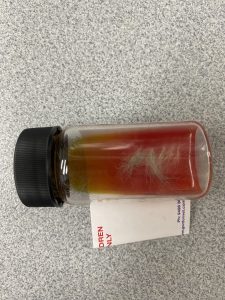Percy’s Present to His New Family
By Kay Hisano | Dated March 13, 2024
Percy’s owners welcomed their new charming kitten to their family. Not soon after, the family members had developed ringworm and had to be treated by their GP. They suspected that they contracted it from Percy. I mean, who can resist giving cuddles to this adorable little one.

Dr. Helen checked Percy thoroughly, but couldn’t notice any obvious ringworm-like lesions. However, she did see some areas of the skin glow under a UV lamp. She took a sample to confirm the ringworm diagnosis and started Percy on an antifungal medication.

Usually, it takes 10-14 days to confirm a diagnosis from a fungal culture, but Percy’s results came back positive in less than a week! The culture showed a bright red color around the fur, confirming ringworm, as shown in the image below.

Ringworm despite it’s name is an infection caused by a fungal infection and not worms.
Ringworm Signs to look out for
- Ringworm in cats typically presents with several noticeable symptoms.
- Round, scaly, and can be either hairless or have broken hairs.
- Often appear on the head, ears, and limbs but can spread to other parts of the body.
- Patchy hair loss, leaving behind bald spots.
- Itching and Irritation
- Red and sometimes crusty
Diagnosing Ringworm in Cats
- Wood’s Lamp Examination
- Some species of ringworm fungi that fluoresce under this light.
- Fungal Culture
- Samples are collected from the patient and cultured to identify the specific fungus responsible for the infection.
- Microscopic Examination
- Skin scrapings or hair samples may be examined under a microscope to visualize fungal structures
Treatment
- Topical Antifungal Therapy including shampoos and creams/ointments
- Oral Antifungal Medications
***WHAT NOT TO FORGET WHEN DEALING WITH RINGWORM***
- Thoroughly clean and disinfect the cat’s living environment
- Isolation
- Infected cats may need to be isolated from other animals to prevent the spread of the infection.
- Zoonosis
- It can be transmitted between animals and humans.
- Practicing good hygiene. Even consider wearing gloves when handling infected animals
- If you notice anything suspicious please go see a GP
